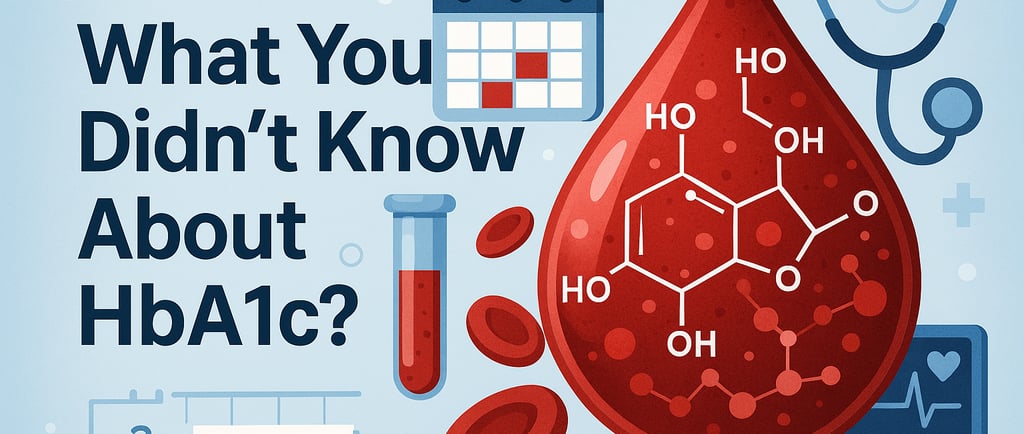HbA1c: Blood Sugar Results
Blog post description.
4/14/20252 min read


HbA1c Myths Busted: Are You Misreading Your Blood Sugar Levels?
A HbA1c blood test shows average blood sugar over the past three months. It measures amount of glucose attached to a protein haemoglobin in red blood cells.
When you hear the term HbA1c, do you think of it as just another blood sugar number? Are you look at the HbA1c value, compare it to standard levels, and quickly draw conclusions as “normal” or “diabetic? If so, you might be overlooking a lot more than you realize.
The HbA1c test—also known as “glycated haemoglobin” or “metabolic memory” test — is far more than a simple diagnostic tool. It gives us deep insight into long-term blood sugar control, helping both patients and doctors make smarter decisions about managing or preventing diabetes. But interpreting this number isn’t always as straightforward as it seems.
The Role of HbA1c in Health
HbA1c plays a crucial role in assessing blood sugar control over a period of 2 to 3 months, thanks to the lifespan of red blood cells, which typically live around 90 days. It shows your average blood glucose over the past 2 to 3 months. It is a long-term indicator of how your body has been managing glucose. It's influenced by more than just your diet—factors like stress, illness, medications, and even certain medical conditions can affect your HbA1c levels.
For those with diabetes, it serves as a key for modifying treatment plans and minimizing complications. For non-diabetics, it can detect prediabetes early, allowing for timely interventions to prevent the onset of diabetes. Yet, interpreting HbA1c is not always as straightforward as it appears.
Understanding HbA1c: More Than Meets the Eye
HbA1c reflects an average of blood sugar levels from the past 12 weeks, based on how glucose binds with haemoglobin in red blood cells. However, it's important to note that HbA1c does not provide a real-time or direct assessment of daily glucose control; instead, it offers a broader snapshot.
Decoding Your HbA1c Report
Did you know HbA1c is influenced by more than just your diet? Stress, illness, and certain medications can all cause fluctuations. Conditions like anaemia or kidney disease can result in falsely high readings, emphasizing the need for careful interpretation by healthcare professionals. While a normal HbA1c level is below 5.7%, individuals with diabetes often aim for around 7%, though targets may vary based on individual health factors.
Misconceptions About HbA1c: Real-Life Scenarios
Doctors often encounter patients with misconceptions about HbA1c. Some believe it reflects a single day’s blood sugar levels, while others assume a higher percentage means better results, likening it to a school grade. Such misunderstandings underscore the need for proper education about HbA1c as a measure of average blood sugar over months—not daily fluctuations.
In one unique case, a patient undergoing treatment for a skin condition showed an unusually low HbA1c result due to the medication Dapsone. Despite the low lab value, home glucose monitoring revealed elevated blood sugar levels. Upon clarification by doctor, the patient understood that the medication had skewed her HbA1c reading. Adjusting her diabetes treatment not only improved blood sugar management but also enhanced overall health.
The Bigger Picture
HbA1c is a powerful tool, but it's not without its complexities. It offers valuable insights into long-term blood sugar trends yet must be interpreted alongside other tests and factors. By understanding the nuances of this, patients and healthcare providers can work together to make informed decisions for better health outcomes.
Next time you review your HbA1c results, remember—it’s not just a number. It’s part of a larger story about your health.
Alok Bains
